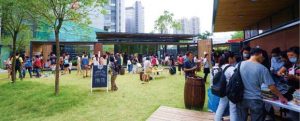//vol.13-2 Interview
- Mr Wong Kam-sing, Secretary for the Environment, talked about climate change and the government’s target for carbon neutrality.
- He says that those concerned about pollution should respond in daily life by modifying their own behaviour, including reducing waste.
- He also says that those passionate about the environment should stay well-informed and seek careers that can help push forward transformation to a lower-carbon world.
- 為應對氣候變化,環境局局長黃錦星表示政府正爭取實現「碳中和」。
- 他認為關注污染問題的青年應身體力行,實踐節能減廢的生活模式。
- 有志之士不但要緊貼環保資訊,更可考慮投身相關產業,進一步推動本港 及世界朝綠色低碳願景邁進。
What do you think is the biggest threat today to Hong Kong’s environmental sustainability?
It is climate change. It not only affects us all today but will seriously affect future generations. The waste problem is another big problem for Hong Kong, the high per capita level of waste generation and the common use of disposable plastics especially.
What do you think is the biggest threat today to Hong Kong’s environmental sustainability?
It is climate change. It not only affects us all today but will seriously affect future generations. The waste problem is another big problem for Hong Kong, the high per capita level of waste generation and the common use of disposable plastics especially.
Do young people have a special contribution to make when caring for the environment
Yes, they have passion and creativity, but they also need to be better prepared. Creativity can help solve environmental problems. It will bring solutions. Then there is the need to take action.
Some young people I have met in recent years are well prepared. They are aware of what we need to do next, but some of them don’t even understand the facts and the latest environmental policies.
What action can youth take?
First, they should go for a low carbon lifestyle. We have a Low Carbon Living Calculator1 to help people assess the carbon emissions associated with their daily lives. Second, they can make good career choices, e.g. joining the environment and technology sectors to push forward the low-carbon transformation. With a combination of creativity and careers, youth can help to change our culture and build a sense of consumer responsibility in the community.
Can you already see efforts being made by Hong Kong youth to make their city’s environment more sustainable?
Yes, there are various groups formed by young people such as Earthero Project, Ecobus, HIKE EXIT and V’air Hong Kong. I met some of them who promote low-carbon local tours, coastal and countryside cleanup, and environmental advocacy and education. For instance, I did country park and beach cleanups with them and we chatted during the process and while hiking.
Also, there are startups whose businesses focus on environmental solutions. One example, which concerns energy saving is BlueSky Energy Technology.2 BlueSky is keen to incentivize people to improve building energy performance through the Internet of Things (IoT) and data.
How do you keep in touch with young people?
We care about voices from different people and young people’s voices are surely treasured. We share with them what we are doing and listen to what they say.
Communication among different stakeholders is important. I am keen to communicate directly, especially with relevant young leaders, and join activities held by them in order to foster communication. Please also note the Government’s Member Self-recommendation Scheme for Youth3 which provides opportunities for young people to participate in policy discussions and understand government operation. People aged between 18 and 35 may self-nominate to become members of specified government advisory committees through the Scheme. Some committees covering sustainable development, energy saving, country parks and countryside conservation, “food wise”, waste reduction etcetera, have recruited young people to participate in various aspects.



Can cross-sectoral collaborations encourage youth to make even further efforts?
With reference to the Paris Agreement, there are three Ps we should try to remember: the public sector, which mainly refers to the government, the private sector, including companies and non-Governmental organizations (NGOs), and the people. To combat climate change, collaborative action should be taken by three Ps. Schools are also very important.
For example, we have launched the “Solar Harvest – Solar Energy Support Scheme for Schools and Welfare Non- Governmental Organisations” with the aim of installing solar photovoltaic (PV) systems at eligible schools and welfare NGOs. The Government has offered a one-stop service including conducting site visits and technical assessments at their premises, design of the solar PV systems, procuring and installing the equipment, and system testing. We have also helped the schools and welfare NGOs apply to join the Feed-in Tariff (FiT) Scheme. All expenses in relation to the solar PV system installation and application to join the FiT Scheme are fully covered by Solar Harvest. We have received over 500 applications, from kindergartens, primary schools, secondary schools and NGOs, and applications are still open.
The project aimed at igniting passion about the environment among students. It not only provides hardware and funding but also offers a practical way for schools to reduce their carbon footprint. We hope that schools can make good use of the solar PV systems installed to enrich the teaching of STEM (science, technology, engineering and mathematics) and environmental education, with a view to fueling the interest of students and young people in exploring science and promoting low-carbon living.
On waste reduction, EPD in collaboration with NGOs has been extending the community recycling network in 18 districts, with a view to strengthening the collection services of recyclables, further encouraging waste reduction and recycling by the general public, and nurturing green living habits in the community. More than 130 public collection points, consisting of nine Recycling Stations, 22 Recycling Stores and more than 100 Recycling Spots, form a new community recycling network GREEN@COMMUNITY and bring a new experience in clean recycling to the public.
The GREEN@COMMUNITY project works well in local communities. In Sheung Wan, for example, where old buildings may have very limited recycling and waste separation facilities, the Recycling Store GREEN@SHEUNG WAN provides a one-stop recycling solution to the nearby occupants. Also, this new network4 works with a large number of buildings and housing estates for off-site recyclable collection and at the same time helps with employment, especially during the pandemic period, when the project employed people of different ages, including young people.
The ENB character 「Big Waster」 is a great eyecatcher. How does he raise awareness of Hong Kong’s problems?
This is the very first government mascot in the world that was given an official blue tick on Facebook! In the old days, our mascot was Lap Sap Chung, the “litter bug”. Today, being a wastrel is a big issue and we can promote the concept effectively through the internet and on social media.
In your vision of a future more livable, less polluted Hong Kong, what changes would you most like to see?
Like other international cities, we have our strengths and limitations. For our targets, I would say there are three “0s” that could make Hong Kong more sustainable and livable. The first zero is about “carbon neutrality” and we act in concert with Hong Kong’s target to achieve this before 2050.5
The second “0” is about electric vehicles and attaining zero vehicular emissions before 2050.6 Last year, there was one EV in every eight new private cars in Hong Kong. It is one of the highest rates among Asian cities. In the “Hong Kong Roadmap on Popularisation of Electric Vehicles”7 launched in March this year, we have initiated a wide range of measures targeting private and commercial vehicles. This acts in concert with our other targets to strive for carbon neutrality in the same time frame and forges ahead with the vision of “Zero Carbon Emissions · Clean Air · Smart City.” Last year, the Government rolled out a $2 billion 「EVcharging at Home Subsidy Scheme” to subsidize the installation of EV charging-enabling infrastructure in car parks of existing private residential buildings.
The third “0” is for “Zero Landfills”.8 Land is really scarce in Hong Kong so we need to focus on waste reduction. We announced the “Waste Blueprint for Hong Kong 2035”9 in February this year, setting out the vision of “Waste Reduction · Resources Circulation · Zero Landfill”. The blueprint outlines the strategies, goals and measures to tackle the
challenge of waste management up to 2035. Under this vision, the Government will work with industry and the community to move towards two main goals. The mediumterm goal is to gradually reduce the per capita Municipal Solid Waste (MSW) disposal rate by 40 to 45 per cent and raise the recovery rate to about 55 per cent by implementing MSW charging, while the long-term goal is to move away from reliance on landfills for direct waste disposal by developing adequate waste-to-energy facilities.
What message of encouragement would you like to send to young people who are concerned about pollution but do not know how to help reduce it?
First, I would say start with daily life and begin with yourself. For example, when you go hiking, always bring your own bottle and leave no trace behind. Second, passionate young people should remember to be well-prepared, wellinformed, up to date and ready for change. Please come and like us on Facebook page and find us on Instagram. It’s one of the best ways to find out the most up-to-date news about what we are doing.

Note: The per capita disposal rates are calculated based on the population (mid-year) updated by the Census and Statistics Department in February 2020.
* Note MSW includes waste from households, institutions and commercial premises but excludes types such as waste from construction. Per capita MSW per person per day in Hong Kong was 1.47 kg in 2019.
Read more
https://www.enb.gov.hk/en/top.html
1. carboncalculator.gov.hk/en
2. blueskyenergy.co
3. hab.gov.hk/en/policy_responsibilities/District_Community_and_Public_Relations/selfrecommendation.htm
4. wastereduction.gov.hk/en/community/crn_intro.htm
5. fso.gov.hk/eng/blog/blog20210207.htm
6. news.gov.hk/eng/2021/03/20210317/20210317_142452_434.html
7. www.enb.gov.hk/sites/default/files/pdf/EV_roadmap_eng.pdf
8. www.info.gov.hk/gia/general/202102/08/P2021020800570.htm
9. www.enb.gov.hk/sites/default/files/pdf/waste_blueprint_2035_eng.pdf


